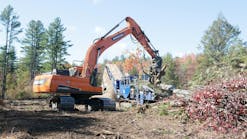When LaVerne DeBoef climbs into the cab of his tub grinder, for the most part, he operates as a one-man crew breaking down wood and yard waste for companies and municipalities across the Midwest. But in some ways, it is very much a family affair.
One of his brothers, Duane, was a product specialist at Vermeer Corp. based in Pella, IA, and was involved in the development of the predecessor to the TG5000 tub grinder he uses. Another brother, Harold, was a farmer who also did grinding around southeast Iowa, and he operated one of the early versions of the TG5000 tub grinder.
“Duane was working with Vermeer and Harold was doing the work,” says LaVerne. “And Vermeer listened to the customer feedback. By the time I got into the business, they had done a pretty good job developing the machine.”
That was a few years ago. LaVerne took early retirement after nearly three decades as a production manager and a trainer at Pella Corp., a window company, and in 2010, helped at Harold’s farm, primarily with the tub grinder. That fall, Harold, who was nearing retirement, asked LaVerne if he wanted to buy the machine.
“I said, ‘Yeah, I think I do,'” says LaVerne. “I really just had a ball running the machine.”
LaVerne DeBoef in front of his TG5000
Harold had a few big customers, most of them wanting pallets ground up and turned into mulch for landscaping. LaVerne began inquiring around southeast Iowa to drum up more business, and he started getting a lot of jobs with public works departments. Operating as DeBoef Grinding out of New Sharon, IA, he says about half his business is from landscaping companies and the other half is from municipalities.
One of those cities is Washington, IA. A county seat with more than 7,000 residents, city crews collect yard waste, tree trimmings, and brush twice a week from April until just before Thanksgiving and take it to a yard at the wastewater treatment facility. Residents can also haul material out there themselves.
The yard waste is mixed in with leaf piles, which are turned at least once a month, says J. J. Bell, the city’s maintenance and construction superintendent. The leaves come from the city’s fall leaf pickup program, when residents rake them to the curb and a city truck comes by and vacuums them up.
After LaVerne grinds the material, it becomes a “hot commodity” as compost that residents can take for free, says Bell. Some of the ground-up wood waste is used as mulch.
LaVerne comes to Washington at least three times per year and generates an estimated 800 cubic yards of finished product each time, says Bell.
“LaVerne has been doing a fabulous job and comes within a week or so after being called,” says Bell.
LaVerne was at the Washington facility in August, working on a windy day under a cloudless blue sky. Using the 27-foot-long optional loader and grapple, he took wood waste and brush from a large pile to his left and dumped it in the rotating tub, each load taking about 15 seconds. The ground-up product then went up the machine’s conveyor belt and into another large pile.
LaVerne had an office job for most of his career at Pella Corp. That’s where he became familiar with wood and the value of recycling, but he enjoys working outside in a more hands-on role.
“I went from being an office person to getting out here and working my tail off,” he says at the Washington job site, the yellow tub grinder and piles of waste and ground-up product behind him. “And it has just been a great, great change.”
LaVerne says he grinds approximately 20,000 tons of material per year across his customer base. He does not sell the product himself. Mulching and bedding companies take the mulch he creates and color it, bag it, and sell it.
“I’m adding value to the product,” says LaVerne. “We grind mountains of mulch.”
Much of his business comes from word of mouth, and what was supposed to be a part-time job in retirement has become more than that. He has some competition, but he says the size of his Vermeer TG5000 tub grinder makes it feasible for him to do jobs that range anywhere from one day to as long as a couple of weeks.
“There are some of the bigger outfits that don’t mess around with these one-day jobs.
So that’s really nice for me,” he says. “And I don’t do many one-day jobs. Usually they’re two- or three-day jobs.”
He gets a lot of jobs that involve grinding pallets, and his tub grinder is a perfect fit for that.
“It’s wonderful on pallets,” he says. “Pallets have nails and staples and screws in them. The TG5000 tub grinder has a pulley on the end of the conveyor that is magnetized, and so they go through the grinder, they are carried on the conveyer until it gets to the end, and then they drop off into a chute.”
Most of the wood waste LaVerne grinds is cut down to 8 feet in length or shorter. What’s nice about a tub grinder, he says, is it can handle root balls and logs with large diameters.
“It tumbles around in the tub and it just kind of keeps spinning and the next thing, it’s gone,” says LaVerne. “The tub grinder is great for big logs.”
Having a grapple provides the added convenience of not having to rely on another piece of equipment or someone else to get the material into the tub. Cities usually provide a wheel loader and an operator to push material toward him, but otherwise he can do the job himself.
He does occasionally get a bit more help. On jobs that last a few days or longer his wife, Carol, will get in a pickup truck and haul a fuel tank to him to refuel the tub grinder. She also helps with cleanup. This adds yet another family connection to the work.
LaVerne’s tub grinder has about 4,000 hours on it. He keeps a strict maintenance schedule that includes hourly, daily, and monthly inspections. With adherence to proper maintenance, it’s still a good, sound machine, he says.
“I put a lot of product through it,” he says. “I’m just pedal to the metal from April to September.”
He gives a nod to his brother Duane, the product specialist, for the Vermeer TG5000 tub grinder’s performance.
His tub grinder has a 540-horsepower engine. He says while he cannot keep up with models that have 1,000 horsepower, he can come pretty close. Also, the grinders from other companies with the same horsepower don’t have as good a cutting operation, he says.
“They can’t even come close to doing what I’m doing,” says LaVerne. “I love the machine, and I have fun running it.”




